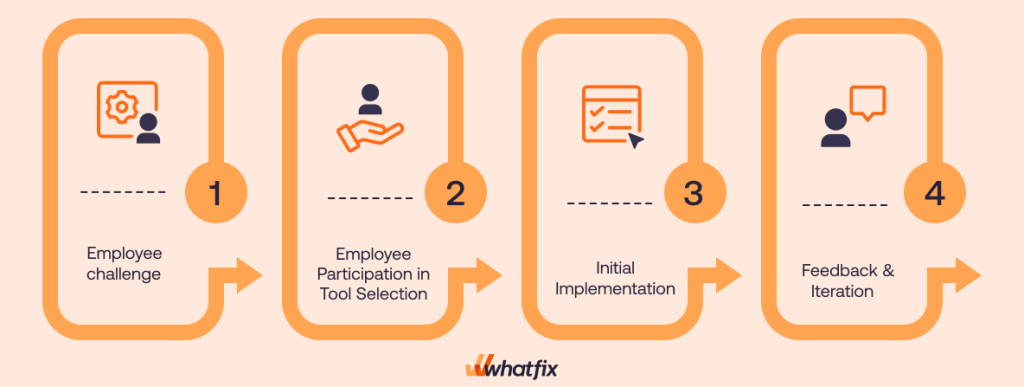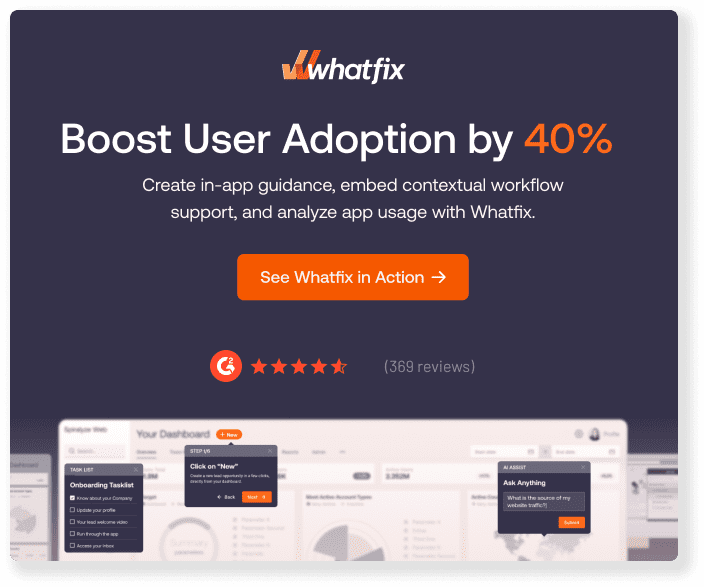The age of generative AI is upon us, and the pressure to utilize it for innovation and efficiency is coming from all directions. However, while 92% of companies plan to increase their AI investments over the next three years, only 1% of leaders believe their organizations are “AI mature.”
The long-term opportunity for AI transformation is estimated to be $4.4 trillion in productivity gains for enterprise use cases. Organizations that fail to harness AI may face significant setbacks, which could lead to falling behind or even complete failure.
With the opportunity so significant and the cost of failure so high, it’s no wonder that companies are scrambling to implement AI into their platforms.
However, simply utilizing AI doesn’t guarantee successful implementation. In this guide, we’ll detail what exactly causes some AI initiatives to fail and how to avoid failed implementation and gain maximum benefit from this exciting period of technological advancement.
What is the failure rate for AI implementation projects?
The Harvard Business Review estimates that the failure rate for AI projects could be as high as 80%, which is staggering when one considers the amount of emphasis and effort being put into AI initiatives. It’s hard to fathom that 80% of these initiatives will go to waste.
As with all statistical data, though, there’s more to the story—and there’s hope, too. As the industry grapples with the challenges of AI implementation, we’re learning from our mistakes. This means your organization can understand the anatomy of a successful AI initiative and optimize for it, avoiding negative outcomes.
Root Causes of AI Implementation Failures
AI has emerged as a transformative force across several industries, promising to enhance efficiency, drive innovation, and unlock new opportunities. However, despite the enthusiasm surrounding AI initiatives, a staggering 80% of these projects fail to achieve their goals. This alarming statistic raises important questions about the underlying factors contributing to such high failure rates.
Here are the core problems resulting in AI implementation failures and how organizational leaders can navigate the complexities of successfully integrating AI into their business operations and workflows.
1. Misaligned on AI use cases
With poor internal communication and a general misunderstanding of AI use cases as the likely culprits, teams are often misaligned on what problem they are solving with an AI initiative and why they are solving it in the first place.
A typical situation is that a technical stakeholder communicates the what—a cool feature powered by AI—and leadership gets excited about it. They get all hands on deck, building it quickly without ever taking the time to strategize and communicate the feature’s value proposition and what needs to happen to ensure it meets a real user need.
To succeed, an AI initiative is like any other product development project: it must meet a user need (whether that’s an internal use case for employees or an external use case for customers), and all stakeholders have to understand what that means to implement something that provides value to users and helps your team meet its business goals.
2. Poor organizational data quality
Artificial intelligence feels magical at times, but the truth is that AI is far from supernatural – it requires quality data to facilitate something useful.
Often, companies try to implement AI functionality without having the necessary data available to the AI. For example, if you’re trying to help your customers with an AI-driven feature that predicts their users’ future behaviors, your feature is only as good as the baseline data you collect about current and past user behavior to make the predictions.
Frequently, companies find that the successful implementation of AI initiatives first requires overhauling the data that will ultimately be used to power and train AI models.
3. Falling for the AI shiny objective syndrome
Shiny object syndrome has always been an issue in tech companies, and the rise of genAI is the current technological advancement that has increased its prevalence exponentially.
Since AI legitimately offers tech solutions that were previously unthinkable, it makes sense that tech leadership is enamored with the possibilities. However, shiny object syndrome is when there is a disproportionate focus on new ideas or solutions to the extent that it causes leaders to lose sight of their core needs, goals, and principles.
In practice, this usually involves implementing an interesting AI-driven feature that doesn’t meet a user need and, therefore, doesn’t advance the company toward its business goals.
4. Inadequate technology infrastructure
Enterprises and growth companies usually utilize cutting-edge technology and have a lot of engineering talent to implement their IT roadmaps. However, in the age of AI, many organizations fail to realize the extent to which success with artificial intelligence implementation requires unprecedented tech needs and particular skill sets on engineering teams.
Often, the implementation of AI-driven technology begins before companies realize that they lack resources such as:
- Engineers who specialize in machine learning or other AI-oriented technologies
- Adequate data storage and management capabilities
- Enough computational resources to both train and run an AI-driven solution
Without these resources, the implementation of AI initiatives can fail before they’ve even started.
5. People-related problems
GenAI technologies are such a game-changing advancement that it requires new technical prowess, organizational change management, and workforce upskilling. Using AI to its full potential demands a shift in mindset, routines, and more from your employees.
Here are some of the employee-oriented challenges that you may encounter as you implement AI into your internal workflows and your platform:
- The need for upskilling and retraining: Whether utilizing AI-driven internal tools or implementing AI-powered features in your internal operations, you’ll likely need cross-functional upskilling and new employee training programs how how to use new conversational chatbot UIs, GenAI best practices, and privacy and security seminars. Some organizations fail to realize this ahead of time or struggle with finding the time and resources to provide adequate user education.
- Resistance to change: Employees feel competent in their current workflows and tools. However, when big internal process and task workflow changes are fueled by new tech like AI, your employees may be unwilling to adapt. Company leaders must utilize change management principles and support employees through times of change with additional performance support, open dialogue with key stakeholders, transparent change communication, and showcase early wins.
- Ethical concerns: Along with AI’s technological advancements come ethical debates around its nature and the moral aspects of its implementation. These debates are happening in real time, and some of your employees may have strong feelings and reservations about how you use AI at your organization. These sentiments can affect their willingness and motivation to work on AI initiatives. Organizations must listen to these concerns and develop a people-centric rollout plan that embraces your company values.
How to Overcome AI Implementation Challenges
In this section, we’ll go through some of the best practices for avoiding or overcoming AI implementation failures so that your organization can reap the unprecedented benefits of AI.
1. Align AI projects to business outcomes
A big part of avoiding shiny object syndrome or failed technology implementations is employing outcome-based solutions and digital transformation initiatives connected to a user need and a measurable business outcome.
The promise of AI can sometimes distract organizations from this principle, and so asking yourself and your team the following questions can help you ensure that your AI initiative is aligned with the business outcomes you hope to achieve:
- What employee or customer need is this AI feature connected to?
- Have we validated this user need through internal stakeholder alignment, root cause analysis, and customer conversations?
- What measurable business outcome or north-star metric will this initiative to influence? (ie. time-to-completion for core processes, customer retention, or increased revenue).
- Can we develop a reasonable plan to ensure every aspect of this change is connected to our desired business outcomes?
Answering these questions as a team can help you eliminate initiatives that won’t ultimately serve the business and free up resources for AI-driven features that will better impact your business outcomes, company goals, internal operations, and customer experience.
2. Focus and prioritize AI projects that solve a specific company challenge
It’s crucial to think about AI as a way to solve company needs and avoid the mistake of framing AI as a specific need itself. When your team uses AI’s power and potential to solve a real need for your team or your customers, you’re much more likely to have a successful implementation.
When it comes to your users, this means applying the exact same product development process to your AI-driven features as you always have. Your team will want to use market analysis, user research techniques, sales and support data analysis, and so on to learn more about your users’ needs.
Using these user needs, your product team and your engineers can come together to figure out how AI might enable new functionality that meets these needs. This way, whatever you implement has a good chance of being utilized by your users, positively impacting metrics like retention and revenue.
AI can also address internal challenges in your organization. For example, you may decide to implement an AI chatbot to relieve a heavy burden on the support team, or AI assistants to help your product team automate tasks like feature documentation. The first step in ensuring the success of internal AI tools is to make sure that they address a real challenge that your employees face.
Here are a few tips for aligning internal AI initiatives to your team’s needs:
- Listen to your employees: What do employees frequently complain about? What do they feel slows them down, or presents a major challenge in their day-to-day work? Your team is the best source of information when it comes to which problems are worth solving.
- Include team members in the implementation process: The employees who will ultimately use the tool should try it out before you commit to purchasing or implementing it so that they can let you know if it really solves the related problem. For example, if you’re considering a few different tools, invite some representatives of the relevant team to attend product demos and make use of free trials.
- Get internal feedback after initial implementation: Even if your team chooses the right tool, there can still be challenges at the beginning such as feature add-ons that you need to purchase in order to meet the internal need, or additional training for employees that wasn’t anticipated. By getting feedback early on, you can help facilitate a successful implementation.

Whether your AI initiative is for your internal team or your customers, you’ll be much more likely to encourage adoption of the new technology if you’re careful to choose tools and features that solve real business problems.
3. Take a people-centric approach to AI adoption
When considering implementing AI tools internally, it’s helpful to think of your employees as users. If you prioritize initiatives that solve core business challenges and create a frictionless employee experience, they’re much more likely to adopt these tools and make their existing workflows more efficient.
Overall, the successful internal implementation of AI tools requires you to take a people-centric approach while avoiding shiny object syndrome or other mindsets that don’t take your team into account.
Here are some best practices for people-centric implementation of internal AI tools:
- Collect end-user feedback from employees about where they struggle, where they think AI would be useful, and the AI implementation overall: Just like user research, internal research is a great place to start understanding needs. Your employees are the best source of information for learning where they feel increased efficiency is needed, and where they think AI can help. This will help your leadership team choose the AI tools and initiatives your employees are most likely to adopt, which will genuinely increase the speed and quality of their work.
- Show your employees how new tools improve the quality or speed of work: Your team wants to do good work, and they want to do it as efficiently as possible. Rather than focusing on the impressive technology behind a new tool, emphasize things like the tool’s ability to automate manual tasks or to provide automated reporting, for example. Use in-app guidance to provide guided tutorials on how AI contextually supports different team members and their contextual tasks (ie. helping to improve their day-to-day.) Your employees will be more interested in adopting the tool because it makes their work more manageable and/or better.
- Upskill and retrain employees for AI tool mastery: Feeling incompetent or lacking knowledge is one of the primary reasons employees don’t adopt new AI tools at their organization. Create a training program for each new tool, including hands-on training and practice. If your employees still don’t feel confident after your initial training session, provide opportunities for continued training until they do. Embed interactive learning experiences into your employees’ workflows and provide performance support in the flow of work. When your team has a sense of mastery, they’ll be much more likely to adopt tools that fully meet their needs.
A people-centric approach to implementing internal AI tools will help your team choose the right tools, influence the right workflows, and excite your employees about integrating what you’ve implemented into their day-to-day work.
With Whatfix for AI adoption, organizations can support new AI implementations by taking a people-centric approach to rollout and integration.
Alert employees of new AI-powered features and GenAI copilots with in-app beacons and tooltips. Provide hands-on user training for new AI agents and chatbots in a risk-free sandbox environment. Guide users through AI-assisted tasks and provide in-app reminders of GenAI best practices. Embed contextual performance support in the flow of work that surfaces AI usage guidelines and SOPs.

With Whatfix, take a people-centric approach to implementing new AI technologies. Increase employee adoption and understanding of your new, AI-driven platform changes by creating immersive, self-service experiences that motivate them to learn new AI tools with the in-app guidance they need to adopt new tasks, tools, and workflows.
You can learn more about how Whatfix enables a people-centric approach to AI adoption here.
5. Invest in data governance programs and technology infrastructure upfront
When your team considers using AI-driven functionality to meet a user or internal need, you’ll need quality data infrastructure for the AI to work optimally and provide value. If possible, review and improve your data infrastructure and governance programs ahead of any AI implementation.
Here are some key questions for your team to consider when making this necessary investment in data:
- What data governance do we have in place today?
- Does our governance address the security, privacy, and accessibility required for AI-driven initiatives?
- Is our user behavior and other customer data accessible enough that key data points can be utilized by AI?
- Does some of the AI functionality we’re considering require new data points? Do we have a plan to obtain and make them accessible?
Though your data team will likely lead this effort, it’s important to consider the investment in your tech infrastructure a cross-functional effort. For example, your product team may have key insights about how you plan to give value to your users with AI, and those details will help your data team understand the data-oriented needs for the AI projects in the roadmap.
Track AI User Engagement to Measure Impact
Effectively tracking how your organization, its departments, and individual end-users engage with and adopt AI tools is critical for attributing GenAI impact, realizing ROI, and continuous improvement. Organizations and leaders must go beyond surface-level AI usage and uncover deep behavioral insights to identify what’s working, what’s not, and where to optimize.
Here are three key areas to help you track AI adoption and measure its ROI:
1. Track AI user engagement across teams
Understanding who engages with your embedded AI copilots and how frequently they’re being used is foundational for tracking adoption and measuring impact.
- Measure DAU and MAU trends across tools and teams to monitor adoption velocity and habitual use.
- Segment usage by role, department, and region to identify adoption gaps and high-performing user groups.
- Identify power users, engaged teams, and successful use cases driving measurable outcomes or innovation across the organization.
2. Map and analyze AI-integrated workflows
AI adoption is only meaningful when it enhances real work. That’s why it’s critical to understand how users are integrating AI into their day-to-day processes.
- Track where and when employees use AI tools in their workflows across apps, systems, and processes.
- Analyze AI interaction sequences to understand how tools are embedded into broader task journeys or decision-making flows.
- Pinpoint user friction or drop-off moments, such as where AI usage is abandoned mid-task or workflows fail to produce expected outputs.
3. Quantify ROI of AI copilots
Organizations need clear attribution between AI usage and business outcomes to justify continued AI investment and build on the foundation they’ve created.
- Track core success metrics tied to AI objectives and business KPIs, such as productivity, data quality, and operational efficiency.
- Attribute AI interactions to outcomes like increased task throughput, faster service delivery, or improved customer satisfaction.
- Benchmark pre- and post-AI implementation metrics, such as time-to-completion, accuracy rates, or decision quality.
- Estimate ROI based on measurable impact, adjusting for tool cost, enablement effort, and the scale of deployment.
With Whatfix Product Analytics, organizations can easily track AI end-user engagement on any enterprise application. Segment end-users based on usage, department, or other cohort types. Map critical workflows to visualize them with Journeys and identify where dropoff is occurring with Funnels.
6. Fill AI talent gaps
Even teams with robust and dynamic engineering departments will likely need to fill some gaps if they’re serious about AI implementation. Skill sets related to machine learning, for example, are often required.
Here are some steps that your team can take to both assess what talent you need and find the right candidates:
- Start with your CTO: Your technical leadership should be well-informed about the nuanced skill sets required for AI implementation.
- Assess needs cross-functionally: Tech leads need to understand the strategic direction the company plans to take and what functionality it wants to offer its users. From there, they can make more specific assessments about who you need to hire.
- Work with recruiting agencies or hire specialized recruiters: Not surprisingly, experts in the realm of AI are highly sought-after employees. Since the field is still emerging, there is a shortage of talent and very high demand. Your team should consider working with recruiters—either by hiring in-house or working with agencies—who know where and how to find the right talent and make your company seem genuinely appealing.
When you finally find candidates with hard-to-source skill sets, there is often pressure to make the offer swiftly. While this makes sense, it’s still important that your hiring team screens for whether or not each candidate is a culture fit. Just like with other positions at your organization, hard skills are important, but they aren’t the sole determinant of long-term success.
6. Build an AI ethics committee and establish data privacy and security best practices
Issues related to AI, ethics, security, and privacy are ongoing global conversations. Your employees and customers are exposed to this dialogue in real time, and they are likely to have concerns about how your organization addresses these contentious issues.
It’s important for your organization to approach issues of ethics, privacy, and security in a systematic way to facilitate the adoption of AI functionality and tools among employees and users. If you take a reactive rather than a proactive approach, you could run into issues with your customers and employees down the line.
The best way to stay on top of these issues as you embark on your journey with artificial intelligence is to establish an AI ethics committee that creates best practices related to ethics, privacy, and security.
This cross-functional team should do the following:
- Establish an easy-to-understand list of ethics, security, and privacy principles your organization can consult when questions arise.
- Define red lines, do’s, and don’ts regarding ethics, privacy, and security for all AI initiatives.
- Create and implement a system for monitoring internal and user-facing AI initiatives to ensure they abide by the above standards.
With a strong committee in place, your team will be well-suited to reassure both customers and employees that you can be trusted to act per ethical standards, protect their data, and provide a secure experience.
AI Adoption Clicks Better With Whatfix
Failure to adopt AI functionality and tooling is a surefire way for your AI initiatives to fail. Many organizations work with Whatfix to facilitate widespread adoption among both employees and customers.
Whatfix fuels the success of AI implementation because it’s a robust, no-code solution for all your adoption needs. In this section, we’ll look at how Whatfix can take your AI projects from idea to adoption among employees and end-users.
Train employees with hands-on learning with Whatfix Mirror
Whatfix Mirror allows you to create an environment that is identical to your platform – but separate. With this sandbox environment, you can enable your employees to learn how to use internal tooling and platform AI features in a risk-free way. This hands-on experience inspires a feeling of mastery that encourages your team to adopt AI tools swiftly.


Use the Whatfix DAP to support employees in the flow of work
Giving team members and users the help they need, exactly when they need it, allows them to learn all about your AI functionality without disrupting their workflows. When your team and customers feel that new AI features fit nicely into their workflow, they’re much more likely to incorporate it into their day-to-day work.
Here are some specific ways in which the Whatfix DAP can help with AI adoption:
- Prompt users and employees with contextual in-app messages at the precise points in their workflows when new AI functionality could provide value
- Give additional guidance on how to prompt and utilize AI features in the moment, using in-app messages, Product Walkthroughs, and more.
- Remind users of data privacy best practices to ensure a secure experience and inspire confidence in your handling of their information.
- Use Surveys to collect real-time feedback from customers after trying your AI features. You can use this information to iterate and improve the experience over time.



Ready to mitigate some of the big challenges with AI implementation with Whatfix? Schedule a demo today!













